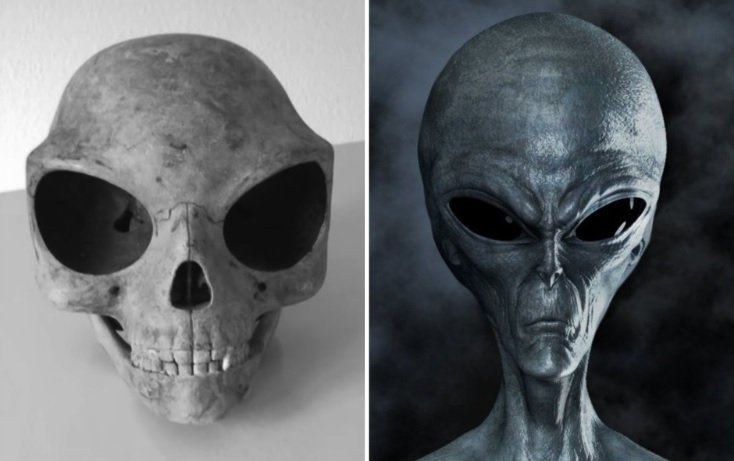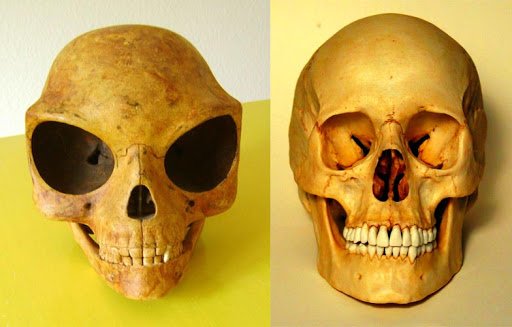
- 2020-09-01
- 0.0 Reitingas
- 965 Peržiūrų
- Aptarti
The story of The Sealand Skull is quite a recent one. The Skull was only discovered in 2007 in the small town of Ølstykke on the Danish island of Sealand. The man who discovered it was a contractor who was hired to replace aging sewer pipes on the property.
The initial discovery was taken with a pinch of salt and somehow considered to be the skull of a horse. A former owner of the property was actually a horse butcher and equine bones were known to have been buried in the rear garden. It was only when the skull was cleaned off when it was fully discovered what a find it had the potential to be.
Coverage of the find was minimal at first, just a few lines in the local press. Regardless of the actual origins of the skull, for little notice to be taken of it can be a mystery in itself.
The first serious study conducted was only attempted in 2010. Scientists at the College of Veterinary Medicine took a closer look at the skull and eventually determined that they could not solve the mystery of the skull to theirs – or anyone’s – satisfaction.
They couldn’t even decide what species the skull belonged to. They did arrive at one definite conclusion; while resembling a mammal, it could not fit into the Linnean Taxonomy because of “certain characteristics”.

Sealand skull (left) and human skull (right)
Unable to make any additional headway, the skull was forwarded to the Niels Bohr Institute in Copenhagen. Like their Veterinarian counterparts, scientists here were unable to provide details surrounding the skull, but did make one crucial discovery. Carbon dating tests did reveal that the skull was almost a thousand years old.
Estimates that the being was alive between 1200 and 1280. That alone ought to rule out any potential hoax as a possibility in regards to authenticity. Further excavations of the site revealed no additional finds which does raise an interesting question: where is the remainder of the skeleton?
Maybe a clue can be found in the discovery of the skull itself. According to rumors, it was actually found above the pipes. Maybe whoever left the skull did so within the last decade or two. Perhaps the skull, along with the yet undiscovered skeleton, were stored in places as diverse as Paris, Munich and the Balkans.
Some insist that was where the skull originally came from. Local residents from generations ago mention a Neolithic clan calling themselves L’Ordre Lux P Pégasos or the Order of Pegasus Light.
These people were said to have been guardians of several items of significance, including a mysterious cranium. Not much is known about this order, but it was known to have been founded in 1350 and rumored members included notable names such as Shakespeare, H.G. Wells and Thomas Jefferson.
Comparing the Sealand Skull to an average human skull, several differences immediately leap out. Aside from being substantially larger, the Sealand Skull has larger eye sockets which are deeper set and have a more rounded orbital shape to them.
The sockets are also wider than a humans and seem less centered. Its nostrils are smaller by comparison and the creature’s chin is a narrow one. The Sealand Skull also has a surface that appears smooth to the touch and could be an indicator that it was adapted or accustomed to a colder environment. It may have also have had nocturnal inclinations.
As further studies into the skull are made, a growing number is more convinced than ever that this is actually the skull of an extra-terrestrial biological entity that passed away a millennia ago and, for whatever reason, was left here.
Was it a scout or colonist from some far off planet, perhaps located inside the Pegasus constellation? Could it have been an unknown human species that has eluded all of science for all of history? If the remainder of the skeleton can be located it could answer many questions.. or ask many more.
Pasaulio naujienas kitaip... skaitykite Paranormal Telegram, FB ir X(twitter) kanale...kadangi jau perskaitėte šį straipsnį iki pabaigos, prašome Jus prisidėti prie šio darbo. Skaitykite „Paranormal.lt“ ir toliau, skirdami kad ir nedidelę paramos sumą. Paremti galite Paypal arba SMS. Kaip tai padaryti? Iš anksto dėkojame už paramą! Nepamirškite pasidalinti patikusiais tekstais su savo draugais ir pažįstamais.
Turite savo nuomone, tapk autoriumi, prisijunk ir rašykite bloge. Dalinkitės receptais, sveikatos patarimais, nutikimais, susidūrėte su nekasdieniškais reiškiniais. Galite išversti iš užsienio kalbos, talpinkite su nuoroda. Laukiame Jūsų straipsnių, naujienų, apžvalgų ar istorijų!
Susijusios naujienos
Būkite pirmi, kurie pasidalins savo nuomonėmis su kitais.
Skaityti daugiau
Skaityti daugiau
Skaityti daugiau
Skaityti daugiau
Skaityti daugiau
Skaityti daugiau
